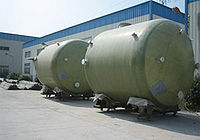GRP Vessels
GRP vessels (Glass reinforced plastic vessels) are very similar with the GRP Tanks (Glass reinforced plastic tanks) which also have a variety of applications and are very common in the chemical and food and drink industries for storing a wide range of materials, some of which are classified as hazardous. Many GRP vessels and tanks are produced annually and the vast majority perform satisfactorily. However, a number have failed in service, with a proportion of these failures being catastrophic. Even in situations where the substances contained are not themselves hazardous, the consequences of a catastrophic failure may be serious. To reduce the risk of such failures, you should be aware of what can go wrong and – more importantly – how to avoid it.
Glass fiber reinforced plastic has a very low thermal conductivity. The actual value is approximately 1/240th of the value for steel. A typical problem with steel tanks and vesssels has always been the high thermal conductivity and expansion of coefficient of steel. These characteristics can cause loosening of the panel connecting bolts in areas of wide temperature change. GRP panels, however, are not affected to such a high degree. Thus, the water stored in GRP panel tanks will not reach the very high temperatures to which the outside of the tank is exposed in semi-tropical or tropical zones.
Video
